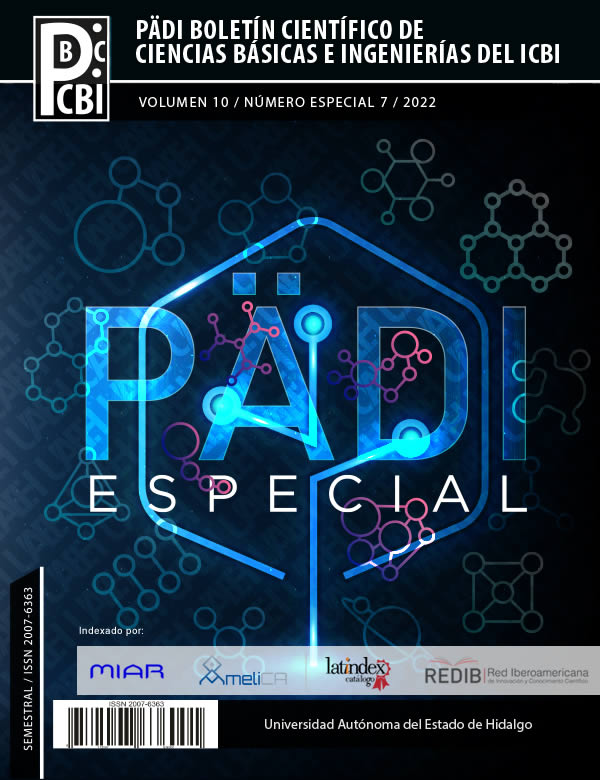Modelado por deposición fundida de polipropileno isotáctico reforzado con nanotubos de titanio (TiNTs).
DOI:
https://doi.org/10.29057/icbi.v10iEspecial7.9817Palabras clave:
Polipropileno, FDM, Propiedades mecánicasResumen
En este trabajo se evaluó el rendimiento de refuerzo de nanotubos de Titania en una matriz de polipropileno isotáctico (iPP). Este refuerzo se añadió al 1,0 y 1,5% en peso en la matriz de polipropileno. Para verificar la formación de la estructura tubular, se realizó un análisis FT-IR, mostrando la presencia de las bandas 912 y 647 cm−1 que corresponden a la región de frecuencia del esqueleto del nanotubo de Titania. Se fabricó un filamento de los nanocompositos para la impresión de probetas mediante FDM con ayuda de una impresora Ender 3 Pro. Las propiedades termo-mecánicas se caracterizaron mediante análisis mecánico dinámico (DMA) donde, para los compositos 1,0 y 1,5% en peso. El módulo de almacenamiento (E') fue superior en comparación con el iPP puro, mostrando una mejoría del (40% y 60%) respectivamente.
Descargas
Información de Publicación
Perfiles de revisores N/D
Declaraciones del autor
Indexado en
- Sociedad académica
- N/D
Citas
Bashir, M. A. (2021). Use of Dynamic Mechanical Analysis (DMA) for Characterizing Interfacial Interactions in Filled Polymers. Solids, 2(1), 108–120. https://doi.org/10.3390/solids2010006
Bertolino, M., Battegazzore, D., Arrigo, R., & Frache, A. (2021). Designing 3D printable polypropylene: Material and process optimization through rheology. Additive Manufacturing, 40(October 2020), 101944. https://doi.org/10.1016/j.addma.2021.101944
Brostow, W., Lobland, H. E. H., & Narkis, M. (2011). The concept of materials brittleness and its applications. Polymer Bulletin, 67(8), 1697–1707. https://doi.org/10.1007/s00289-011-0573-1
Carneiro, O. S., Silva, A. F., & Gomes, R. (2015). Fused deposition modeling with polypropylene. Materials and Design, 83, 768–776. https://doi.org/10.1016/j.matdes.2015.06.053
Cheng, S., Lau, K. tak, Liu, T., Zhao, Y., Lam, P. M., & Yin, Y. (2009). Mechanical and thermal properties of chicken feather fiber/PLA green composites. Composites Part B: Engineering, 40(7), 650–654. https://doi.org/10.1016/j.compositesb.2009.04.011
Gonzalez-Calderon, J. A., Fierro-Gonzalez, J. C., Peña-Juarez, M. G., Perez, E., & Almendarez-Camarillo, A. (2022). Influence of the chemical functionalization of titanium oxide nanotubes on the non-isothermal crystallization of polypropylene nanocomposites. Journal of Materials Science, 57(10), 5855–5872. https://doi.org/10.1007/s10853-022-07009-x
Gonzalez-Calderon, J. A., Vallejo-Montesinos, J., Mata-Padilla, J. M., Pérez, E., & Almendarez-Camarillo, A. (2015). An effective method for the synthesis of pimelic acid/TiO2 nanoparticles with a high capacity to nucleate β-crystals in isotactic polypropylene nanocomposites. Journal of Materials Science, 50(24), 7998–8006. https://doi.org/10.1007/s10853-015-9365-6
Hertle, S., Drexler, M., & Drummer, D. (2016). Additive Manufacturing of Poly ( propylene ) using Melt Extrusion. 1–12. https://doi.org/10.1002/mame.201600259
Jin, M., Neuber, C., & Schmidt, H. (2020). Tailoring polypropylene for extrusion-based additive manufacturing. Additive Manufacturing, 33(January), 101101. https://doi.org/10.1016/j.addma.2020.101101
Morgan, D. L. (2010). Alkaline Hydrothermal Treatment of Titanate. Queensland University of Technology, August, 172.
Muniyappan, S., Solaiyammal, T., Sudhakar, K., Karthigeyan, A., & Murugakoothan, P. (2017). Conventional hydrothermal synthesis of titanate nanotubes: Systematic discussions on structural, optical, thermal and morphological properties. Modern Electronic Materials, 3(4), 174–178. https://doi.org/10.1016/j.moem.2017.10.002
Spoerk, M., Arbeiter, F., Raguž, I., Weingrill, G., Fischinger, T., Traxler, G., Schuschnigg, S., Cardon, L., & Holzer, C. (2018). Polypropylene Filled With Glass Spheres in Extrusion-Based Additive Manufacturing: Effect of Filler Size and Printing Chamber Temperature. Macromolecular Materials and Engineering, 303(7). https://doi.org/10.1002/mame.201800179
Spoerk, M., Holzer, C., & Gonzalez-Gutierrez, J. (2020). Material extrusion-based additive manufacturing of polypropylene: A review on how to improve dimensional inaccuracy and warpage. Journal of Applied Polymer Science, 137(12), 1–16. https://doi.org/10.1002/app.48545
Stribeck, N. (2014). Functionalization of multi-walled carbon nanotubes ( MWCNTs ) with pimelic acid molecules : effect of linkage on b -crystal formation in isotactic polypropylene ( iPP ) matrix. https://doi.org/10.1007/s10853-014-8706-1
Tajvidi, M., Falk, R. H., & Hermanson, J. C. (2006). Effect of natural fibers on thermal and mechanical properties of natural fiber polypropylene composites studied by dynamic mechanical analysis. Journal of Applied Polymer Science, 101(6), 4341–4349. https://doi.org/10.1002/app.24289
Tian, X., Todoroki, A., Liu, T., Wu, L., Hou, Z., Ueda, M., Hirano, Y., Matsuzaki, R., Mizukami, K., Iizuka, K., Malakhov, A. v., Polilov, A. N., Li, D., & Lu, B. (2022). 3D Printing of Continuous Fiber Reinforced Polymer Composites: Development, Application, and Prospective. Chinese Journal of Mechanical Engineering: Additive Manufacturing Frontiers, 100016. https://doi.org/10.1016/j.cjmeam.2022.100016
Vidakis, N., Petousis, M., Velidakis, E., Tzounis, L., Mountakis, N., Kechagias, J., & Grammatikos, S. (2021). Optimization of the Filler Concentration on Fused Filament Fabrication 3D Printed Polypropylene with Titanium Dioxide Nanocomposites. Materials, 14(11), 3076. https://doi.org/10.3390/ma14113076
Wang, L., & Gardner, D. J. (2017). Effect of fused layer modeling (FLM) processing parameters on the impact strength of cellular polypropylene. Polymer, 113, 74–80. https://doi.org/10.1016/j.polymer.2017.02.055
Wang, L., Sanders, J. E., Gardner, D. J., & Han, Y. (2018). Effect of fused deposition modeling process parameters on the mechanical properties of a filled polypropylene. Progress in Additive Manufacturing, 3(4), 205–214. https://doi.org/10.1007/s40964-018-0053-3




















